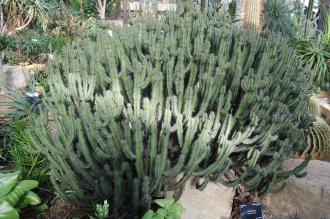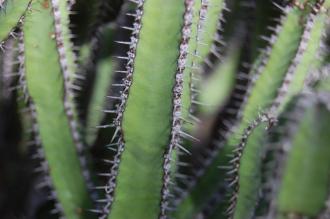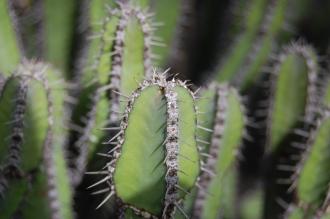
Euphorbia polyacantha (28/02/2016, Kew Gardens, London)
Position: Full sun
Flowering period: Early summer
Soil: Moist, well drained
Eventual Height: 1.5m
Eventual Spread: 2m
Hardiness: 10b, 11, 12, 13
Family: Euphorbiaceae
Euphorbia polyacantha is a succulent, cactus like plant with a spreading habit. Its modified grey/ green leaves are completely attached to the stem along one edge and have pairs of thorns along the other. Its spines are up to 6mm long. Its branches are erect, up to 4cm across (including leaf) and has a candelabra like crown. Its yellow flowers are borne at the stem apex.

Euphorbia polyacantha Stem (28/02/2016, Kew Gardens, London)
Euphorbia polyacantha, commonly known as Fishbone Thistle or Fish Bone Cactus, is native to south Yemen, Sudan and Ethiopia. In its native habitat it grows on rocky slopes in shrubby thickets, often at the edge of Juniperus forests.
The etymological root of the binomial name Euphorbia is derived from Euphorbus, after the name of the Greek physician of King Juba II of Numidia. Polyacantha is derived from the Greek polys meaning ‘many’ and akanthos meaning ‘thorn’.
The landscape architect may find Euphorbia polyacantha useful as an attractive specimen houseplant. It may also be planted as part of a xeriscaping scheme in atriums.
Ecologically, Euphorbia polyacantha is of little value to UK wildlife.

Euphorbia polyacantha Growing Tip (28/02/2016, Kew Gardens, London)
Euphorbia polyacantha prefers a very well-drained soils. It tolerates most pH of soil.
When maintaining Euphorbia polyacantha as a houseplant its soil should be watered sparingly, never wet. Watering should be almost stopped during the winter months. Its preferred active growing temperature rages from between 20ºc to 28ºc, although it will tolerate a temperature as low as 10ºc. Feeding with weak fertiliser solution should be carried out once a month during the growing season.

Landscape Architecture

